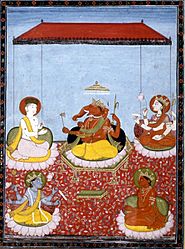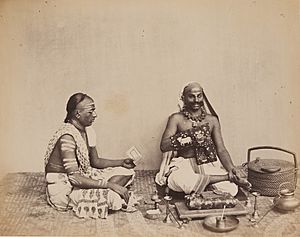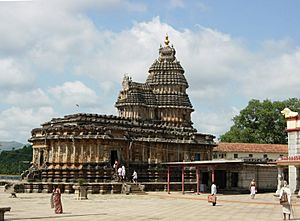Smarta tradition facts for kids

The five primary deities Of Smarta in a Ganesha-centric panchayatana: Ganesha (centre) with Shiva (top left), Adi Shakti (top right), Vishnu (bottom left), and Surya (bottom right)
|
|
| Founder | |
|---|---|
| Adi Shankara | |
| Religions | |
| Hinduism | |
| Scriptures | |
| Vedas • Smritisastras | |
| Languages | |
| Sanskrit, Old Tamil | |
| Related ethnic groups | |
| Babburkamme, Iyer, Deshastha, Hoysala Karnataka Brahmins, etc |

The Smarta tradition is a special way of practicing Hinduism. It grew and became popular with the Puranas, which are ancient Hindu stories and texts. This tradition combines different ideas like Advaita Vedanta (which teaches about oneness) and Yoga.
A key part of the Smarta tradition is that it doesn't pick just one main god. Instead, followers worship five main gods in their homes: Ganesha, Shiva, Shakti, Vishnu, and Surya. All these gods are seen as equally important. The Smarta tradition is different from older traditions that focused more on complicated rituals.
This tradition became well-known around the beginning of the Common Era. It is closely linked to Advaita Vedanta philosophy. Many people see Adi Shankara as the founder or a major reformer of the Smarta tradition. He taught that the ultimate reality is beyond any specific form or name. Because of this, Smarta followers often include a sixth, formless idea of God in their worship, alongside the five main gods.
The word Smarta can also refer to Brahmins (a priestly class in Hinduism) who are experts in a group of Hindu texts called the Smriti. These texts are different from the Sruti texts (like the Vedas), which are considered older and were passed down verbally.
Contents
What Does Smarta Mean?
The word Smarta (स्मार्त) comes from Smriti (स्मृति). Smriti texts are Hindu writings that were usually written down by authors. They are different from Sruti texts, which are believed to have no human author and were passed down by speaking.
Smarta can mean several things:
- Something related to memory.
- Something based on or found in the Smriti texts.
- Something based on tradition or allowed by old laws.
- An Orthodox Brahmin who knows or follows traditional law and Vedanta teachings.
In the Smarta tradition, Smarta means "a follower of Smriti." It is often connected to the group started by Shankaracharya.
A Brief History of the Smarta Tradition
The Smarta tradition began to grow during the early Classical Period of Hinduism. This was a time when Hinduism was forming through the mix of older Brahmanic ideas and local traditions.
How Hinduism Grew
Historians believe the Smarta tradition started as a way to bring together different Hindu ideas. This period, sometimes called the "Hindu synthesis," happened between about 500 BCE and 467 CE. During this time, Hindu ideas developed by interacting with other religions like Buddhism and Jainism.
The Smriti texts from this period (around 200 BCE to 100 CE) said that the Vedas were very important. Accepting the Vedas became a key way to define Hinduism. The Smriti texts explained the Vedas in different ways, leading to six main schools of Hindu philosophy. Two of these, Mimamsa and Vedanta, are sometimes called Smarta schools because they are based on the Sruti (Vedic) tradition.
Around the start of the Common Era, different Hindu ideas began to blend. The Smarta schools mixed with older ideas of devotion (bhakti) and other traditions. This led to the growth of major groups like Shaivism (worship of Shiva), Vaishnavism (worship of Vishnu), and Shaktism (worship of Shakti).
The Smarta tradition tried to unite these different ways of worship. It taught that all gods are different forms of the same ultimate reality, called Brahman. This led to the practice of pancayatana-puja, where people could choose to focus on any of five main gods (Vishnu, Shiva, Durga, Surya, and Ganesha) as a step towards understanding the formless Brahman.
Adi Shankara's Role
Adi Shankara (who lived in the 8th century) is seen as a very important teacher and reformer of the Smarta tradition. He taught that the Upanishads (part of the Vedas) show that everything is one, a concept known as nondualism.
Shankara helped bring the Advaita philosophy closer to the Smarta tradition. He supported the idea of varnasramadharma (social and religious duties based on one's class and stage of life). He also helped popularize the pancayatana-puja (five-shrine worship) as a way to unite different devotional practices. This meant people could choose their favorite god (istadevata) from the five main deities.
The Sringeri Sharada monastery in Karnataka, founded by Adi Shankara, is still a very important center for the Smarta tradition today.
Smarta as a Recognized Tradition
Over time, scholars recognized Smarta as a distinct tradition, separate from Vaishnavism and other groups. It is often described as a group of Hindus who follow traditional Brahmanical ideas and practices. Smartas usually believe in a unified Hinduism and avoid extreme divisions between different groups.
The Smarta tradition first appeared as a way to bring Hinduism together into a non-sectarian form, based on the Vedic heritage. It accepted the ideas of Varna (social classes) and ashrama (four stages of life) as religious duties. Adi Shankara later refined this movement with his Advaita Vedanta philosophy. The Smarta tradition teaches that all gods are equal and are different ways of seeing the all-powerful, formless Brahman.
Smarta Beliefs and Practices
Panchayatana Puja: Worshiping Five Deities
A key practice for Smartas is called Panchayatana puja. In this type of worship, followers honor one or more of five Hindu deities: Surya (the Sun god), Shiva, Vishnu, Ganesha, and Adi Shakti (the Divine Mother).
Often, symbols of these five gods are placed on a special round metal plate called a Panchayatana. The symbol of the worshiper's favorite god is placed in the center. You can also see this idea in old temples, where the main god's shrine is surrounded by four smaller shrines for other deities. Some Smartas in South India also include a sixth god, Kartikeya.
While this practice is often linked to Adi Shankara, old archaeological finds show that Panchayatana puja was done long before he was born. Some sets of these worship arrangements have been found from as early as the Kushan Empire (before 300 CE).
Saguna and Nirguna Brahman: God with and without Form
In Smartism, the ultimate reality, called Brahman, is beyond all the different forms of personal gods. Smartas accept the Vedas and the ideas of Atman (the soul) and Brahman.
The Smarta tradition understands Brahman in two ways:
- Saguna Brahman: This is Brahman with attributes or qualities. It's like thinking of God with a form, name, or specific characteristics.
- Nirguna Brahman: This is Brahman without any attributes or qualities. It's the unchanging, ultimate reality that is beyond all forms.
The idea of saguna Brahman is seen as a helpful step for people on their spiritual journey. It's a way to connect with the divine. But for those who are fully enlightened, the saguna concept is no longer needed because they realize their own soul (Atman) is the same as the formless nirguna Brahman. A Smarta can choose any saguna deity (their istadevata) as a way to move towards understanding the nirguna Brahman.
Important Texts
Smartas follow the Hindu scriptures. These include the shruti (the Vedas) and, very importantly, the smriti literature. The smriti texts helped bring in ideas from other traditions and the growing bhakti (devotion) movement into the Brahmanical way of life.
Many basic ideas and practices of Hinduism come from the smriti texts. While the shruti is important to a few Brahmins, the smriti texts are important to most Hindus, no matter their class or caste.
The main truth in this tradition is that the Atman (your soul) and Brahman (the ultimate reality) are the same, and they are eternal and unchanging. The philosophical parts of the Vedas, especially the Upanishads, are key here. Along with the Upanishads, the Bhagavad Gita and Brahma Sutras are central texts for the Advaita Vedanta tradition. They teach about the oneness of Atman and Brahman.
Some major Smriti texts include:
- The two great epics: the Ramayana by Valmiki and the Mahabharata. Many Smarta thinkers have written about these. They are still very popular for daily reading and storytelling. The Ramayana has guided Hindu thought for centuries.
- The Bhagavad Gita, which is part of the Mahabharata. It shows how Brahmanic ideas mixed with bhakti traditions.
- The Puranas, which are collections of mythological stories about different Hindu gods, especially Shiva and Vishnu. The Srimad Bhagavatham and Vishnu Purana are highly respected and used for daily reading.
- Common religious law books, or dharma literature, like the Manu Smriti.
Smarta Institutions

The Smarta tradition includes temples and monasteries. More Smarta temples are found in West and South India than in North India.
Adi Shankara, a leading scholar of the Smarta Tradition, founded some of the most famous monasteries in Hinduism. These monasteries, called Maṭhas, are located in four directions: Dwarka in the West, Jagannatha Puri in the East, Sringeri in the South, and Badrinath in the North. He also established the Kanchi Kamakoti Peetam in Kanchi. Each matha was led by one of his students, called a Shankaracharya, who continued to teach Advaita Vedanta.
These mathas still exist today and continue Shankara's teachings and influence. The Sringeri Sharada monastery in Karnataka is the main center for Smarta followers.
Smarta Brahmins and Visvakarmas
Smarta Brahmins

The word Smārta is also used to describe a Brahmin who follows the Smriti texts.
Smarta Brahmins are different from Srauta Brahmins, who focus on the Sruti texts (like the Brahmanas within the Vedas). They are also different from Brahmins who specialize in Agamic (Tantra) texts. However, these groups are not always strictly separate. Many orthodox Vedic groups have also started focusing on temple worship, which is a Smarta and Agamic tradition.
In a broader sense, most Brahmins who are not part of small, very traditional Vedic groups are considered Smarta Brahmins.
Smarta Visvakarmas
Visvakarmas are skilled artisans in South India, known for crafts like blacksmithing, carpentry, and sculpture. Smarta Visvakarmas are vegetarian artisans who follow the Smarta tradition. They are different from Vaishnava Visvakarmas, who follow the Vaishnavism tradition.
Influence of the Smarta Tradition
The Smarta Brahmins have been very important in shaping a shared Indian identity. They strongly follow the "pan-Indian Sanskrit-Brahmanical tradition." This tradition helped create a vision of India that influenced the idea of a united nation. In the Tamil region, this vision was closely linked to the Tamil Brahmins, especially the Smarta Brahmins, who were seen as strong supporters of this pan-Indian tradition.
See also
 In Spanish: Smarta para niños
In Spanish: Smarta para niños
- Neo-Vedanta
- Advaita Vedanta
- Ishta-deva
- Smarana
- Prominent Smarta teachers
- Sects
Examples of groups that follow the Smarta tradition and Advaita Vedanta, with Shankaracharya as a key reformer:
- Halenadu Karnataka Brahmin
- Hoysala Karnataka Brahmins
- Iyers

